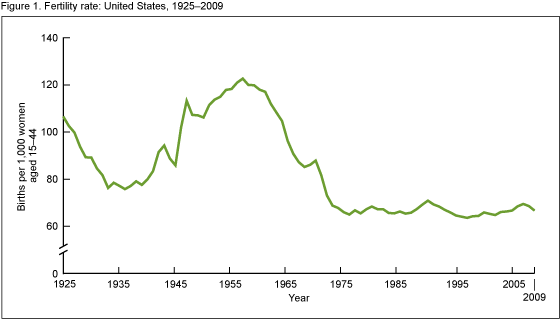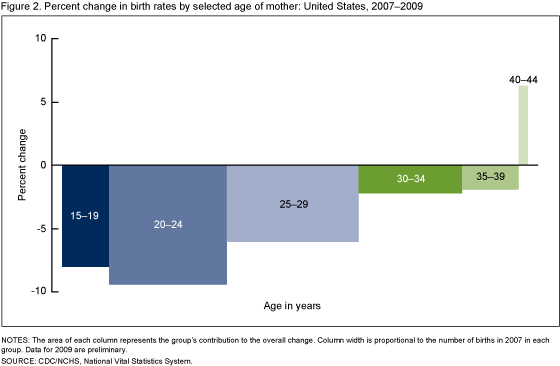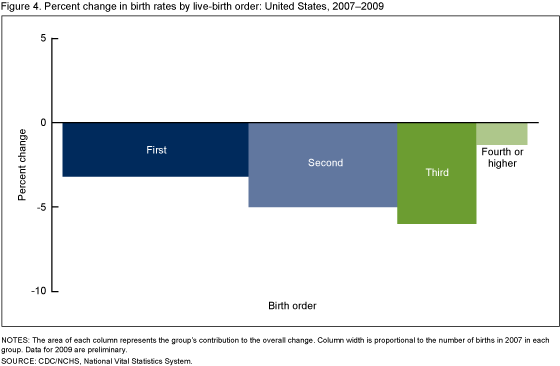Contact Us:
- National Center for Health Statistics
3311 Toledo Rd
Hyattsville, MD 20782 - 1 (800) 232-4636
- cdcinfo@cdc.gov
NCHS Data Brief
Number 60, March 2011
Recent Decline in Births in the United States, 2007–2009
On this Page
- Key findings
- Fertility rates fell more rapidly from 2007 through 2009 than for any 2-year period in more than 30 years.
- Birth rates declined for mothers under age 40 but rose for mothers aged 40 and over.
- Fertility rates for Hispanic women fell more than for any other population group.
- Birth rates declined for all live-birth orders.
- Fertility rates fell most rapidly in the western and southeastern United States.
- Summary
- Definitions
- Data sources and methods
- About the authors
- References
- Suggested citation
PDF Version (1 MB)
Paul D. Sutton, Ph.D.; Brady E. Hamilton, Ph.D.; and T.J. Mathews, M.S.
Key findings
- From 2007 through 2009, birth rates for women aged 15–44 (fertility rates) fell for most states and nearly all major population subgroups.
- Birth rates declined for all women under age 40 with some of the largest decreases for women in their peak childbearing years.
- Fertility rates dropped for all major racial and Hispanic groups with the largest declines among Hispanic women.
- Birth rates by live-birth order also fell with the largest declines for third-order births and progressively smaller declines for second- and first-order births.
- Fertility rates decreased or were unchanged in every state and the District of Columbia with the largest declines among western and southeastern states.
The number of births in the United States reached an all-time high of 4,316,233 in 2007, but that number has since fallen (1–3). From 2007 through 2009, births fell 4 percent to 4,131,019; and the provisional count of births through June 2010 indicated continued declines (3). Fertility rates—which relate the number of births to women aged 15–44 (i.e., the childbearing years)—also fell during this time frame.
This report takes a more detailed look at the decline in births from 2007 through 2009 by mother's age, race and ethnicity, birth order, and state. The analysis is based on a comparison of 2007 final and 2009 preliminary birth data from the National Vital Statistics System (NVSS), and are the most current detailed birth data available.
Keywords: fertility decline, birth rates , race and Hispanic origin, state rates
Fertility rates fell more rapidly from 2007 through 2009 than for any 2-year period in more than 30 years.
- From 2007 through 2009, the fertility rate fell 4 percent from 69.5 to 66.7 births per 1,000 women aged 15–44.

NOTES: Data for 2009 are preliminary. Access data table for Figure 1 [PDF - 37 KB].
SOURCE: CDC/NCHS, National Vital Statistics System.
- The fertility decline from 2007 through 2009 is relatively small in a historical context compared with the declines in the early 20th century and in the 1960s and early 1970s (Figure 1). The most recent extended period of fertility decline was in the 1990s when the fertility rate fell 10 percent from 1990 through 1997 to an all-time low of 63.6. With the exception of a small decline from 2000 through 2002, the fertility rate between 1997 and 2007 increased.
- It is not yet known if fertility rates will experience another extended decline, but provisional data indicate a continuing decline in the rate through June 2010 (3).
Birth rates declined for mothers under age 40 but rose for mothers aged 40 and over.
- From 2007 through 2009, birth rates fell for all women under age 40 (Figure 2 and Table).
- Birth rates fell 9 percent for women aged 20–24 (to 96.3 births per 1,000 women, the lowest rate ever recorded for this age group), and 6 percent for women aged 25–29. Rates also declined for women in their 30s (2 percent each).
Table. Fertility rates, birth rates, and percent change by selected age: United States, final 2007 and preliminary 2009
[Rate per 1,000 women in specified group. Population estimates as of July 1]
| Age in years | Rate | Percent change, 2007–2009 | |
|---|---|---|---|
| 2007 | 2009 | ||
| 15–44 | 69.5 | 66.7 | -4 |
| 10–14 | 0.6 | 0.5 | -17 |
| 15–19 | 42.5 | 39.1 | -8 |
| 20–24 | 106.3 | 96.3 | -9 |
| 25–29 | 117.5 | 110.5 | -6 |
| 30–34 | 99.9 | 97.7 | -2 |
| 35–39 | 47.5 | 46.6 | -2 |
| 40–44 | 9.5 | 10.1 | 6 |
| 145–49 | 0.6 | 0.7 | 17 |
Table. Fertility rates, birth rates, and percent change by selected race and origin of mother: United States, final 2007 and preliminary 2009
[Rate per 1,000 women in specified group. Population estimates as of July 1]
| Race or origin | Rate | Percent change, 2007–2009 | |
|---|---|---|---|
| 2007 | 2009 | ||
| Non-Hispanic white2 | 60.1 | 58.5 | -3 |
| Non-Hispanic black2 | 71.6 | 68.9 | -4 |
| Hispanic3 | 102.2 | 93.3 | -9 |
| American Indian or Alaska Native2,4 | 64.9 | 62.8 | -3 |
| Asian or Pacific Islander2,4 | 71.3 | 68.7 | -4 |
Table. Fertility rates, birth rates, and percent change by live-birth order of child: United States, final 2007 and preliminary 2009
[Rate per 1,000 women in specified group. Population estimates as of July 1]
| Live-birth order5 | Rate | Percent change, 2007–2009 | |
|---|---|---|---|
| 2007 | 2009 | ||
| 1st child | 27.9 | 27.0 | -3 |
| 2nd child | 22.1 | 21.0 | -5 |
| 3rd child | 11.7 | 11.0 | -6 |
| 4th child and over | 7.8 | 7.7 | -1 |
1 Birth rates computed by relating births to women aged 45 and over to women aged 45–49.
2 Race and Hispanic origin are reported separately on birth certificates.
3 Includes all persons of Hispanic origin of any race.
4 Data for persons of Hispanic origin are included for this race group.
5 Figures for live-birth order not stated are distributed.
NOTE: All percent changes are statistically significant.
SOURCE: CDC/NCHS, National Vital Statistics System.
- The birth rate for teenage women (aged 15–19) also declined, falling 8 percent from 2007 through 2009 (to 39.1 births per 1,000 women, the lowest rate ever recorded for this age group) (4).
- Birth rates rose for women in their 40s, the only age group to do so. The rate rose 6 percent for women aged 40–44. Births to women in this age group, however, represented only 3 percent of total births in 2009.
Fertility rates for Hispanic women fell more than for any other population group.
- From 2007 through 2009, fertility rates dropped for all racial and ethnic groups (Figure 3 and Table).
- The fertility rate for Hispanic women fell 9 percent from 2007 to 2009, to 93.3 per 1,000 women, the lowest rate for Hispanic women since 1999 and the largest decline of any group.
- The fertility rate for non-Hispanic white women (accounting for over one-half of all births) declined 3 percent.
- The fertility rate also fell 3 percent for American Indian or Alaska Native women and 4 percent for non-Hispanic black and Asian or Pacific Islander women.
Birth rates declined for all live-birth orders.
- From 2007 through 2009, birth rates declined for all live-birth orders (Figure 4 and Table).
- The first birth rate for women aged 15–44 fell 3 percent and the second-order birth rate fell 5 percent in 2009. First- and second-order births accounted for nearly three-quarters of births in 2009.
- The third- and fourth- or higher-order birth rates also declined in 2009 (down 6 percent and 1 percent).
Fertility rates fell most rapidly in the western and southeastern United States.
- State-specific fertility rates in 2009 were significantly lower than they had been in 2007 for 42 states (Figure 5). Fertility rates in the other eight states and the District of Columbia were essentially unchanged.
- Fertility rates fell in most states, but the size of the decline varied widely from 1 percent in New York and Oklahoma to 10 percent or more in Arizona and Nevada.
- Declines were largest in the western and southeastern United States.

NOTES: Data for 2009 are preliminary. Access data table for Figure 5 [PDF - 37 KB].
SOURCE: CDC/NCHS, National Vital Statistics System.
Summary
The fertility rate in the United States fell 4 percent from 2007 through 2009, to 66.7 births per 1,000 women aged 15–44. The 2-year decline was notable, but not truly of historic proportions when compared with the large, extended fertility declines in the early 20th century and in the 1960s and early 1970s. Nevertheless, the fertility rate decline from 2007 through 2009 was broad-based, both demographically and geographically. Rates fell for all women under age 40, for all major racial and ethnic groups, for all birth orders, and in most states (42 total). However, substantial differences in the size of the declines among groups were present.
Some researchers have linked the recent fertility decline to the economic recession (5), but it is not possible with birth data alone to identify the factors shaping the fertility rate decline.
Definitions
Fertility rate: The number of live births per 1,000 women aged 15–44 in specified group.
Birth rate by age of mother: The number of live births per 1,000 women in specified age group.
Birth rate by live-birth order: The number of live births of the specified birth order per 1,000 women aged 15–44.
Data sources and methods
This report contains data from the NVSS Natality Data Files. The vital statistics natality files include information for all births occurring in the United States. The natality files include information on a wide range of maternal and infant demographic and health characteristics for babies born in the United States. Data may also be accessed from the interactive data tool, VitalStats.
For information and discussion on the computation of population-based rates and on significance testing for natality data, see "Births: Preliminary Data for 2005" (6) and "User Guide to the 2008 Natality Public Use File" (7).
Birth data for 2009 are preliminary (2). Information on the 2009 data is available elsewhere (2). Population data for computing fertility rates were provided by the U.S. Census Bureau. Rates by state may differ from rates computed on the basis of other population estimates (8).
About the authors
Paul D. Sutton, Brady E. Hamilton, and T.J. Mathews are with the Centers for Disease Control and Prevention's National Center for Health Statistics, Division of Vital Statistics, Reproductive Statistics Branch.
References
- Martin JA, Hamilton BE, Sutton PD, et al. Births: Final data for 2008 [PDF - 1.6 MB]. National vital statistics reports; vol 59 no 1. Hyattsville, MD: National Center for Health Statistics. 2010.
- Hamilton BE, Martin JA, Ventura SJ. Births: Preliminary data for 2009 [PDF - 419 KB]. National vital statistics reports; vol 59 no 3. Hyattsville, MD: National Center for Health Statistics. 2010.
- Sutton PD. Recent trends in births and fertility rates through June 2010. National Center for Health Statistics Health E-Stat. 2010.
- Ventura SJ, Hamilton BE. U.S. teenage birth rate resumes decline. NCHS data brief, no 58. Hyattsville, MD: National Center for Health Statistics. 2011.
- Cohn D, Livingston G. U.S. birth rate decline linked to recession. Social & Demographic Trends Report. Pew Research Center. 2010.
- Hamilton BE, Martin JA, Ventura SJ. Births: Preliminary data for 2005 [PDF - 474 KB]. National vital statistics reports; vol 55 no 11. Hyattsville, MD: National Center for Health Statistics. 2007.
- National Center for Health Statistics. User guide to the 2008 natality public use file [PDF - 1.2 MB].
- Hamilton BE, Sutton PD, Ventura SJ. Revised birth and fertility rates for the 1990s and new rates for Hispanic populations, 2000 and 2001: United States [PDF - 1.2 MB]. National vital statistics reports; vol 51 no12. Hyattsville, MD: National Center for Health Statistics. 2003.
Suggested citation
Sutton PD, Hamilton BE, Mathews TJ. Recent decline in births in the United States, 2007–2009. NCHS data brief, no 60. Hyattsville, MD: National Center for Health Statistics. 2011.
Copyright information
All material appearing in this report is in the public domain and may be reproduced or copied without permission; citation as to source, however, is appreciated.
National Center for Health Statistics
Edward J. Sondik, Ph.D., Director
Jennifer H. Madans, Ph.D., Associate Director for Science
Division of Vital Statistics
Charles J. Rothwell, M.S., Director





